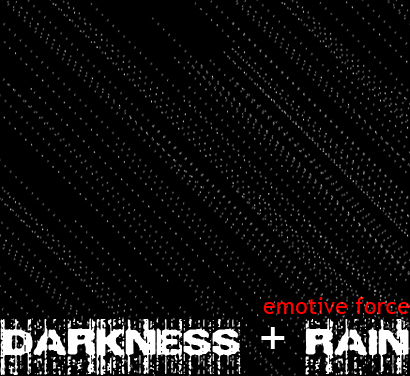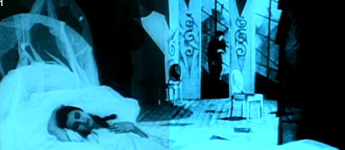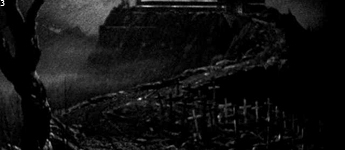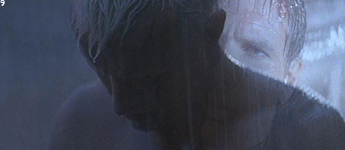       
ARCH 443/646 ARCHITECTURE + FILM. MICHAEL CC LIN. UWSA. 2006
|
Emotive Force |
|
|
Fear + Dystopia
The use of darkness and rain in the films achieve different goals of enhancing as well as distorting atmospheres, environments, and characters. Most of all, their use in the films generates an emotive force of dystopia and fear.

|
Alphaville reveals a Paris filmed in the recent-past but evokes a dystopic mood with an overwhelming use of darkness. A computer-run city with no individuality is immersed in an eternal night. Similarly, Akira uses a palette of colour illustrative of nighttime. A mechanized, hyper-developed city like Blade Runner and Metropolis, the Neo-Tokyo of Akira is overrun by crime, corruption, and unrest. The city is dark and unfriendly and its colours suggest just that.
|
 |
| Sin City shows the audience an extreme of corruption and evil. The film uses stark black in white shades recalling the imagery of the graphic novels they are based on. An overarching feeling of distress and fear is ever-present in the world of Sin City where darkness is the norm. |
 |

In Blade Runner, the prevalence of decay and hopelessness is enforced but a dominating darkness and ever-present rain. As we approach the end of the movie, we find a moment of light in this heavy darkness when the Replicant Roy saves the life of Deckard, just before his life expires on a rooftop near the Bradbury Building . The rain in this scene, just as morning breaks, can be seen as the one single moment in the film where instead of an element of decay, it is a source of cleansing and redemption. The life of Deckard saved by Roy consequently leads to the sparing of Rachael's life as they escape together. Roy 's own life is much less fortunate and as he fades into the darkness, like the city itself is slowly fading, the despair and utter hopelessness in his words, “All those moments will be lost in time. Like tears in rain. Time to die.” resounds loud and clear with the futureless doomed world, one plagued with rain and darkness. |
In the Cabinet of Dr. Caligari, the twisted and tormented shapes of the world in Francis' mind form an expressionistic environment that disorients and unsettles. The contrast between light and dark is exaggerated by painted shadows. Further distortion is achieved where the settings disappear into darkness; the stairs in the police station and exterior streets in various scenes. The added blue filter for darkness where all the murders happen enhances the drama and heightens the suspense and fear already created by the characters and the sets. The darkness plays with the audience's fear of the unknown and is demonstrated in the scene when Caligari lures Jane into his tent where all we see is a stark white glove waving her into a pitch black tent.
|
The Black Cat begins with a dark and stormy night and continues the feeling of impending doom portrayed from the weather into the mansion itself, complementing the menacing personalities of Hjalmar and Vitus. The cold, dismal setting set upon a graveyard, immersed in darkness, traps Peter and Joan in a frightful nightmare of murder and Satanism. The darkness hiding the evil secrets of the house and revealing them one bit at a time, stirring up suspense and horror throughout the movie. |
 |
 |
 |
 |
| images: 1) the murderous deeds carried out at night in the dark and twisted world of Caligari. 2) the shadows indicate the act. 3) a dark and stormy night in which an ominous fate awaits the guests in The Black Cat. 4) Sam Lowry's wild imaginaiton of dark forces represent the oppression experienced in real life in Brazil. 5) Neo-Tokyo of Akira with its shades and tints of nighttime. 6) a beat up Hartigan clings on for life in the dark and rainy woods as he seeks a little justice in evil Sin City. 7) darkness that hides identities and probing lights in Blade Runner. 8,9) a glimpse of hope and a confirmation of hopelessness in a city plagued by rain and darkness. |
The darkness in Metropolis 1927 as well of 2001 evokes a sense of oppression. The dystopic lower levels are in stark contrast with the bright utopian upper levels. The overworked proletariat and the robots workers are kept deep down in a world of grime and decay, in a seemingly never-ending night. The true natures of the dystopic cities are revealed in both movies and the darkness invades the utopia above ground spreading fear and wreaking havoc.
The evils lurking in the shadows of Sam Lowry's imagination in Brazil represent the oppressive powers that he struggles against in the real world. Darkness is the evil forces of his nightmares and the source of great fear.
 |